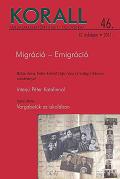A menekültlét arcai. Örmény menekültek és a menekültügy kialakulása
The Faces of Refugee Status. The Armenian Emigrants and the Evolution of the Refugee Cause
Author(s): Anna BirkásSubject(s): History
Published by: KORALL Társadalomtörténeti Egyesület
Summary/Abstract: The question of refugees was one of the main social issues of the League of Nations during the first decade of its operation. The first official institution which was defining the term of refugee in international perspective was the High Commission for Refugees of the League of Nations founded in 1920 by Fridtjof Nansen. He was the inventor of the so-called Nansen-passport, an internationally accepted certificate for identification, aiming to let the stateless refugees cross the borders of the nation-states. While the general term of ’refugee’ was not represented during the 1920s, there were a few refugee causes in the international discussion, which were distinguishing this type of migration from other emigrations. One of the recognized movements was the Armenian refugee’s cause, concerning the Armenians running away from persecution in the territories of the former Ottoman Empire. Focusing on a less macro level, in this study, the social situation of Armenian refugees is approached by the analysis of a unique document, a registration book, which was composed in 1924–1925 by the delegation of the High Commission for Refugees in Greece. The document preserved some basic statistical data about the Armenian refugees temporary settled in Salonica area, who also appear in mini portraits on the pages of the register. The informations about the refugee families reveal the social effect of the refugee existence on the unwanted population, especially in the changes of roles in the family according to the gender. Being defined as an Armenian refugee and the experience of being unwanted by ethnicity deepens the senses of Armenianness for these people coming from a minority status. The process of the forced migration meant also a kind of individualisation, which could be described as a symbolic step from the traditional Ottoman society to Europe in a specific period of modernisation.
Journal: Korall - Társadalomtörténeti folyóirat
- Issue Year: 2011
- Issue No: 46
- Page Range: 42-65
- Page Count: 24
- Language: Hungarian

